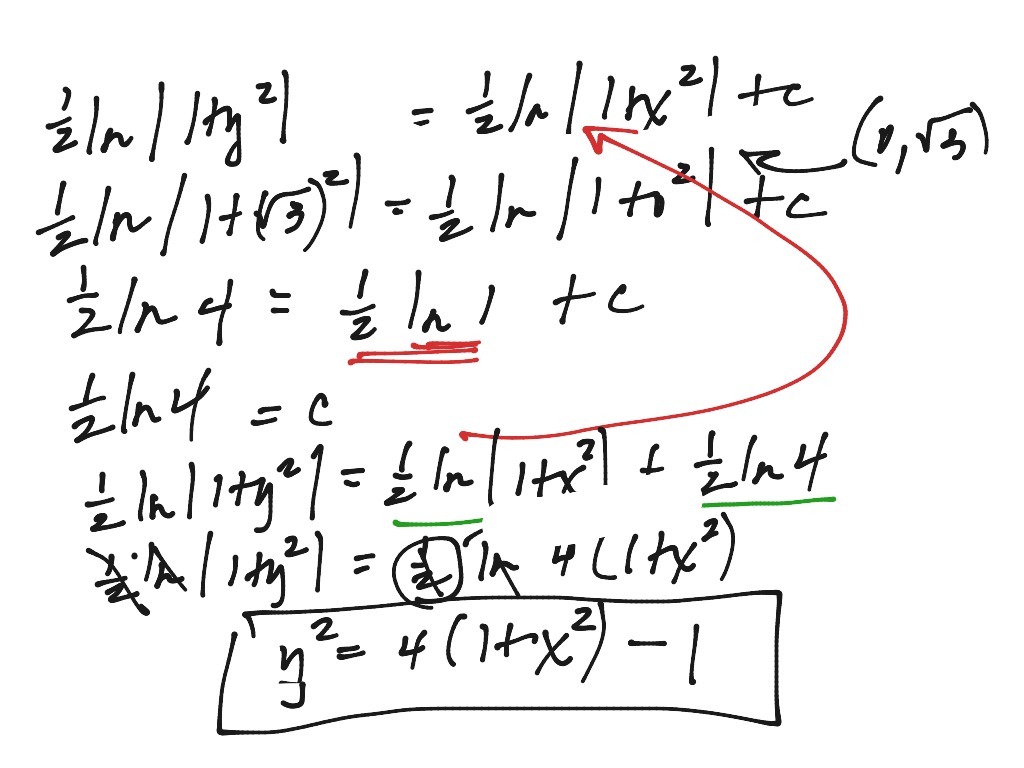We have already seen how to compute slopes of curves given byparametric equations—it is how we computed slopes in polarcoordinates.
- 10.5 Differential Equationsap Calculus Transcendentals
- 10.5 Differential Equationsap Calculus Calculator
Differential equations are equations that include both a function and its derivative (or higher-order derivatives). For example, y=y' is a differential equation. Learn how to find and represent solutions of basic differential equations. This is a lesson from the tutorial, Differential Calculus and you are encouraged to log in or register, so that you can track your progress. Showing 2 items from page AP Calculus More Integration and Differential Equations Videos sorted by Day, create time. View more » Homework. Assignment Day Answer Key. Differential Equations 2019 AB4/BC4 Rain barrel: A cylindrical barrel collects rainwater, with questions relating the rates of the water height and volume, and a separable differential equation to solve explicitly for the height as a function of time t.
Example 10.5.1 Find the slope of the cycloid $x=t-sin t$, $y=1-cos t$.We compute $x'=1-cos t$, $y'=sin t$, so $${dyover dx} ={sin tover 1-cos t}.$$Note that when $t$ is an odd multiple of $pi$, like $pi$ or $3pi$,this is $(0/2)=0$, so there is a horizontal tangent line, in agreementwith figure 10.4.1. At even multiples of $pi$, thefraction is $0/0$, which is undefined. The figure shows thatthere is no tangent line at such points.
Areas can be a bit trickier with parametric equations, depending onthe curve and the area desired. We can potentially compute areasbetween the curve and the $x$-axis quite easily.
10.5 Differential Equationsap Calculus Transcendentals
Example 10.5.2 Find the area under one arch of the cycloid$x=t-sin t$, $y=1-cos t$. We would like to compute$$int_0^{2pi} y;dx,$$but we do not know $y$ in terms of $x$. However, the parametricequations allow us to make a substitution: use $y=1-cos t$to replace $y$, and compute $dx=(1-cos t);dt$. Then the integralbecomes $$int_0^{2pi} (1-cos t)(1-cos t);dt=3pi.$$Note that we need to convert the original $x$ limits to $t$ limitsusing $x=t-sin t$. When $x=0$, $t=sin t$, which happens only when$t=0$. Likewise, when $x=2pi$, $t-2pi=sin t$ and$t=2pi$. Alternately, because we understand how the cycloid isproduced, we can see directly that one arch is generated by $0le tle 2pi$. In general, of course, the $t$ limits will bedifferent than the $x$ limits.

This technique will allow us to compute some quite interesting areas,as illustrated by the exercises.
As a final example, we see how to compute the length of a curve givenby parametric equations. Section 9.9 investigatesarc length for functions given as $y$ in terms of $x$, and developsthe formula for length:$$int_a^b sqrt{1+left({dyover dx}right)^2};dx.$$Using some properties of derivatives, including the chain rule, we canconvert this to use parametric equations $x=f(t)$, $y=g(t)$:$$eqalign{ int_a^b sqrt{1+left({dyover dx}right)^2};dx&= int_a^b sqrt{left({dxover dt}right)^2 +left({dxover dt}right)^2left({dyover dx}right)^2};{dtover dx};dxcr &=int_u^v sqrt{left({dxover dt}right)^2+ left({dyover dt}right)^2};dtcr &=int_u^v sqrt{(f'(t))^2+(g'(t))^2};dt.cr}$$Here $u$ and $v$ are the $t$ limits corresponding to the $x$ limits$a$ and $b$.
Example 10.5.3 Find the length of one arch of the cycloid.From $x=t-sin t$, $y=1-cos t$, we get the derivatives$f'=1-cos t$ and $g'=sin t$, so the length is $$ int_0^{2pi} sqrt{(1-cos t)^2+sin^2 t};dt= int_0^{2pi} sqrt{2-2cos t};dt.$$Now we use the formula $ds sin^2(t/2)=(1-cos(t))/2$ or$ds 4sin^2(t/2)=2-2cos t$ to get$$int_0^{2pi} sqrt{4sin^2(t/2)};dt.$$Since $0le tle2pi$, $sin(t/2)ge 0$, so we can rewrite this as$$int_0^{2pi} 2sin(t/2);dt = 8.$$
Exercises 10.5
Ex 10.5.1Consider the curve of exercise 6 in section 10.4. Find all values of$t$ for which the curve has a horizontal tangent line.(answer)
Ex 10.5.2Consider the curve of exercise 6 in section 10.4. Find the area underone arch of the curve.(answer)
Ex 10.5.3Consider the curve of exercise 6 in section 10.4. Set up an integralfor the length of one arch of the curve.(answer)
Ex 10.5.4Consider the hypercycloid of exercise 7 in section 10.4. Find all points atwhich the curve has a horizontal tangent line.(answer)

Ex 10.5.5Consider the hypercycloid of exercise 7 in section 10.4. Find the area between thelarge circle andone arch of the curve.(answer)
Ex 10.5.6Consider the hypercycloid ofexercise 7 in section 10.4. Find the length of one arch of the curve. (answer)
Ex 10.5.7Consider the hypocycloid of exercise 8 in section 10.4. Find the area inside the curve.(answer)
Ex 10.5.8Consider the hypocycloid ofexercise 8 in section 10.4. Find the length of one arch of the curve. (answer)
Ex 10.5.9Recall the involute of a circle fromexercise 9 insection 10.4. Find the point in the firstquadrant in figure 10.4.4 at which the tangent line is vertical.(answer)

Ex 10.5.10Recall the involute of a circle fromexercise 9 insection 10.4. Instead of an infinitestring, suppose we have a string of length $pi$ attached to the unitcircle at $(-1,0)$, and initially laid around the top of the circlewith its end at $(1,0)$. If we grasp the end of the string and beginto unwind it, we get a piece of the involute, until the string isvertical. If we then keep the string taut and continue to rotate itcounter-clockwise, the end traces out a semi-circle with center at$(-1,0)$, until the string is vertical again. Continuing, the end ofthe string traces out the mirror image of the initial portion of thecurve; see figure 10.5.1. Find the areaof the region inside this curve and outside the unit circle.(answer)

Ex 10.5.11Find the length of the curve from the previous exercise,shown in figure 10.5.1.(answer)
Ex 10.5.12Find the length of the spiral of Archimedes(figure 10.3.4) for $0lethetale2pi$.(answer)
A collection of test-prep resources
Help students score on the AP® Calculus exam with solutions fromTexas Instruments. The TI in Focus program supports teachers inpreparing students for the AP® Calculus AB and BC test. Our libraryof files covers free-response questions (FRQ) from past examsthrough the lens of graphing technology.
10.5 Differential Equationsap Calculus Calculator
Below you’ll find released AP® Calculus questions from the last fewyears. Each section (or module) leads to a page with videos,downloads and learning objectives related to each free-responsequestion.
